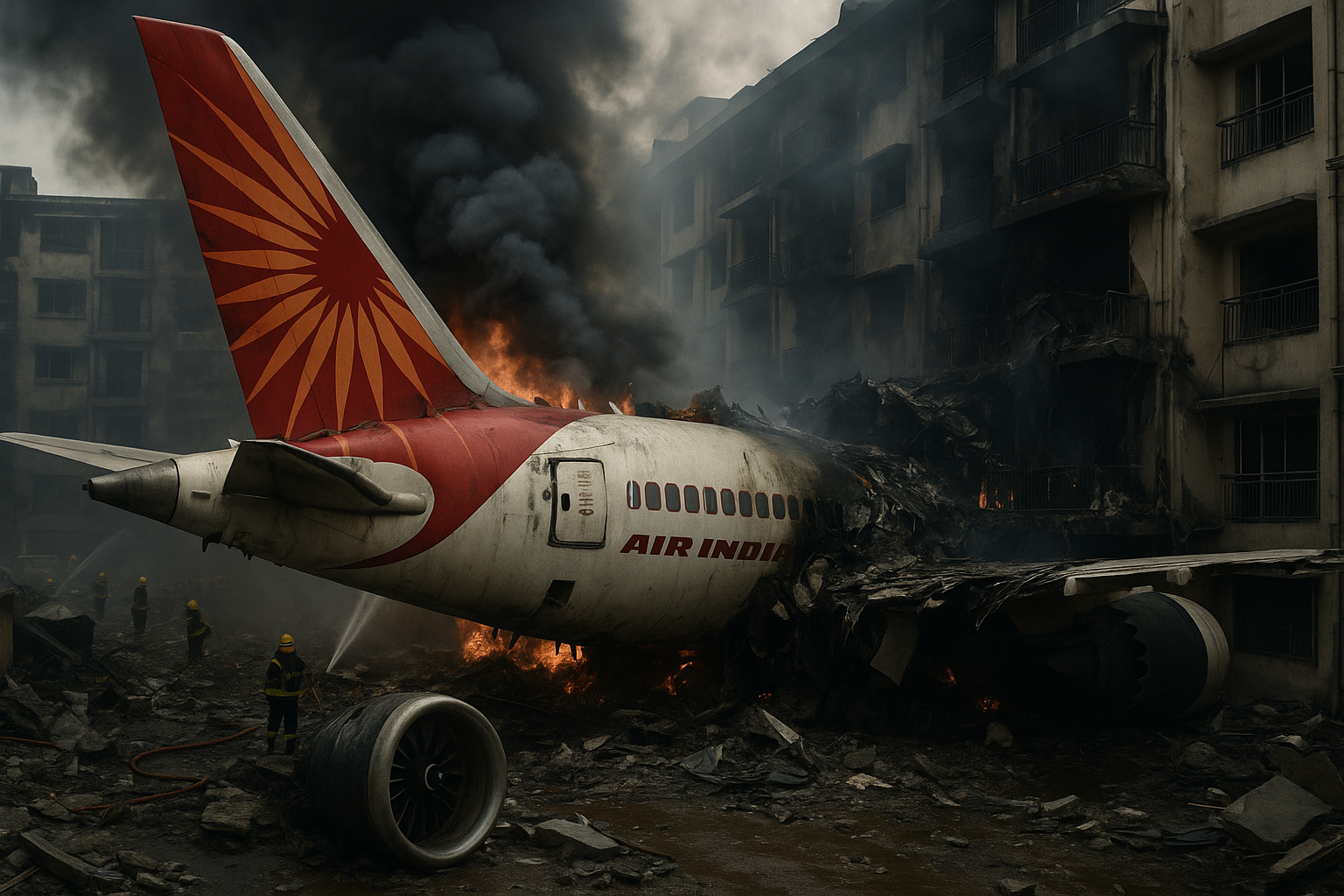Tragedy Strikes Ahmedabad Air India Boeing 787 Crash Prompts Urgent Safety Review
Ahmedabad, India A catastrophic aviation disaster unfolded on June 12, 2025, when Air India Flight AI171, a Boeing 787-8 Dreamliner bound for London Gatwick, crashed moments after takeoff from Sardar Vallabhbhai Patel International Airport. The incident, which saw the aircraft plummet into a medical hostel complex in Ahmedabad’s Meghaninagar area, has resulted in a devastating loss of life, killing 241 passengers and crew on board, with at least 29 additional fatalities on the ground, making it one of India’s worst aviation tragedies in decades.
The crash has sent shockwaves through the global aviation industry and prompted immediate, high-level investigations by Indian authorities with international assistance from the U.S. and U.K.
The Moments Before Disaster A ‘Mayday’ Call and Rapid Descent
According to preliminary reports from the Civil Aviation Ministry spokesperson, Flight AI171 took off at approximately 1:39 PM. Within seconds of becoming airborne, the pilots radioed Ahmedabad Air Traffic Control (ATC) with a “Mayday!” call, reporting “Thrust not achieved…” before going silent. Eyewitness accounts and a widely circulated video filmed by a local teenager captured the aircraft struggling to gain altitude, its engines reportedly shrieking before it descended rapidly. The plane crashed less than 2 kilometers from the runway, impacting a medical college hostel and a residential area. The tail section of the Dreamliner was seen protruding from the building, a chilling image of the devastation.
One passenger, Vishwas Kumar Ramesh, is reported as the sole survivor from the aircraft, adding a layer of poignant detail to the tragedy.
Initial Theories and Investigation Challenges
Investigators from India’s Aircraft Accident Investigation Bureau (AAIB) are working tirelessly to determine the cause of the crash, with crucial assistance from experts from the UK, the US, and Boeing. The flight data recorder (FDR) and cockpit voice recorder (CVR), collectively known as the “black boxes,” were recovered from the wreckage. However, reports indicate these devices sustained heavy fire damage, making immediate data extraction in India unfeasible. Plans are underway to send the damaged black boxes to the United States for specialized analysis by the National Safety Transport Board (NTSB) in Washington, a process that could take weeks or months.
Despite the ongoing investigation, preliminary theories are emerging. Aviation experts are closely examining the deployment of the Ram Air Turbine (RAT) – a small emergency power generator – which was likely active before the crash. The RAT automatically deploys in flight if both engines fail or if all hydraulic system pressures are low, suggesting a potential double engine failure or a total electrical/hydraulic malfunction. While Air India’s CEO Campbell Wilson stated that the Boeing 787-8 Dreamliner was “well-maintained,” with its last major check in June 2023 and the right engine overhauled in March 2025, investigators are still working to understand why the thrust was not achieved. Pilots Captain Sumeet Sabharwal and First Officer Clive Kunder were highly experienced, with over 13,400 hours of flying experience combined.
Broader Safety Concerns and Industry Response
This incident marks the first fatal crash for a Boeing 787 Dreamliner since its market introduction in 2011, making the investigation’s findings particularly critical for Boeing and the global aviation community. The crash has reignited concerns about aircraft safety, especially following other recent incidents involving Boeing aircraft globally.
In response, India’s Directorate General of Civil Aviation (DGCA) immediately ordered enhanced surveillance and safety inspections of Air India’s entire fleet of Boeing 787 Dreamliners, comprising 33 aircraft. While initial checks reportedly “did not reveal any major safety concerns” and aircraft were found compliant with existing safety standards, the DGCA did flag “maintenance-related issues” at Air India, advising the airline to strengthen internal coordination across departments and ensure adequate spare parts.
As a confidence-building measure and due to the time consumed by these additional checks, Air India has decided to reduce its international wide-body flights by approximately 15% from June 20 until at least mid-July. This temporary reduction aims to allow more backup aircraft to be ready and enhance pre-flight safety checks.
Prevention and The Path Forward
Preventing such tragedies hinges on a meticulous investigation that identifies all contributing factors. This includes:
- Black Box Data Analysis: The accurate retrieval and analysis of data from the FDR and CVR are paramount to reconstruct the final moments of the flight and understand system performance, pilot inputs, and cockpit environment.
- Wreckage Examination: Forensic analysis of the debris can reveal signs of structural failure, fire, mechanical issues, or other anomalies.
- Maintenance Records Review: A thorough examination of the aircraft’s maintenance history, recent servicing, and any reported glitches is crucial.
- Human Factors: Analysis of pilot training, fatigue, and crew communication, while initial reports suggest experienced pilots, remains standard in any investigation.
- Environmental Factors: Weather conditions, air traffic control interactions, and potential foreign object debris (FOD) on the runway are also considered.
The Indian government has established a high-level committee to examine the crash causes and formulate procedures to prevent and handle future aircraft emergencies. A preliminary report is expected within three months. The focus now is not just on understanding what went wrong on June 12, but on implementing changes that ensure such a devastating event is never repeated, reinforcing the commitment to passenger safety in India’s rapidly growing aviation sector.





